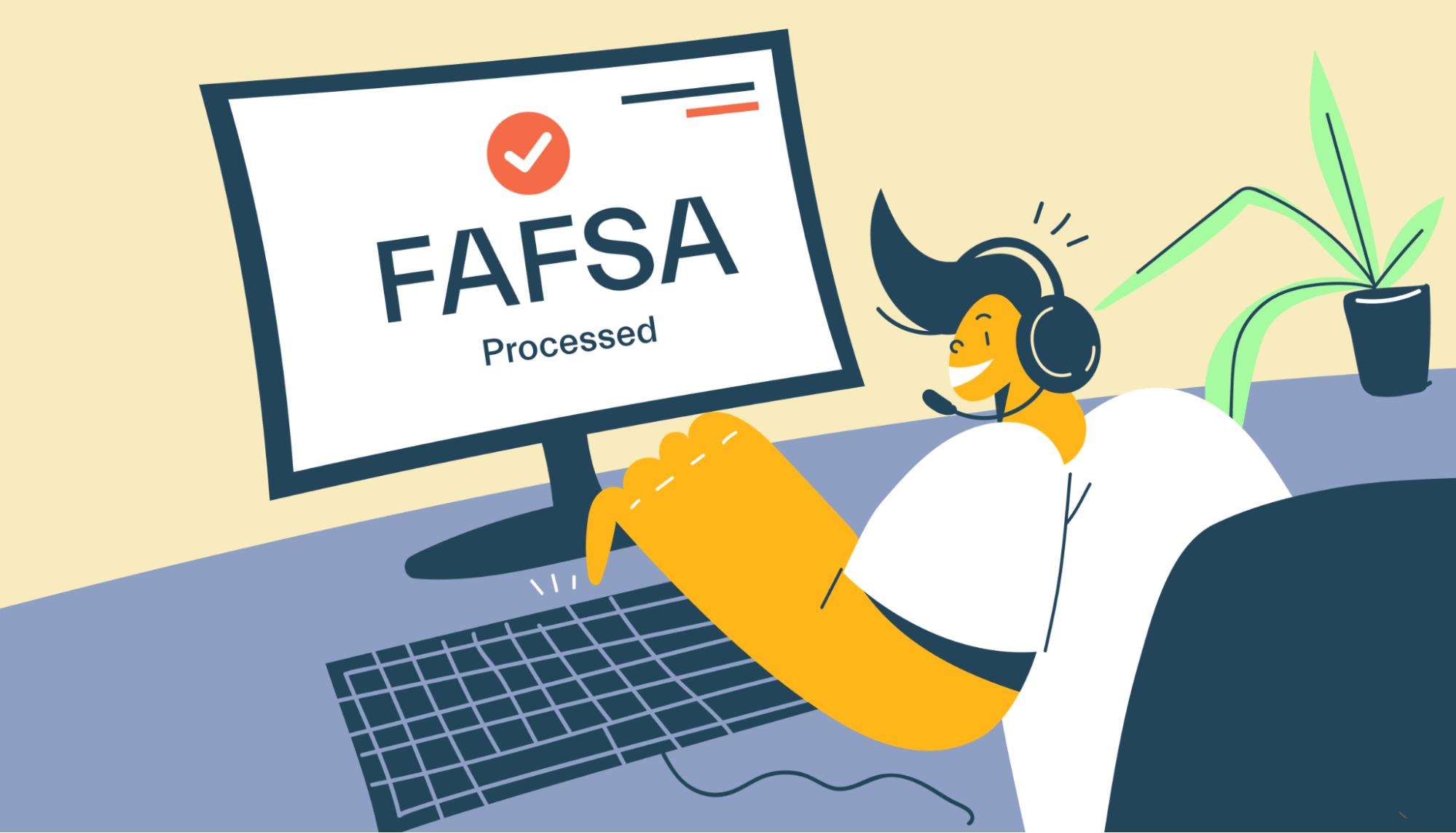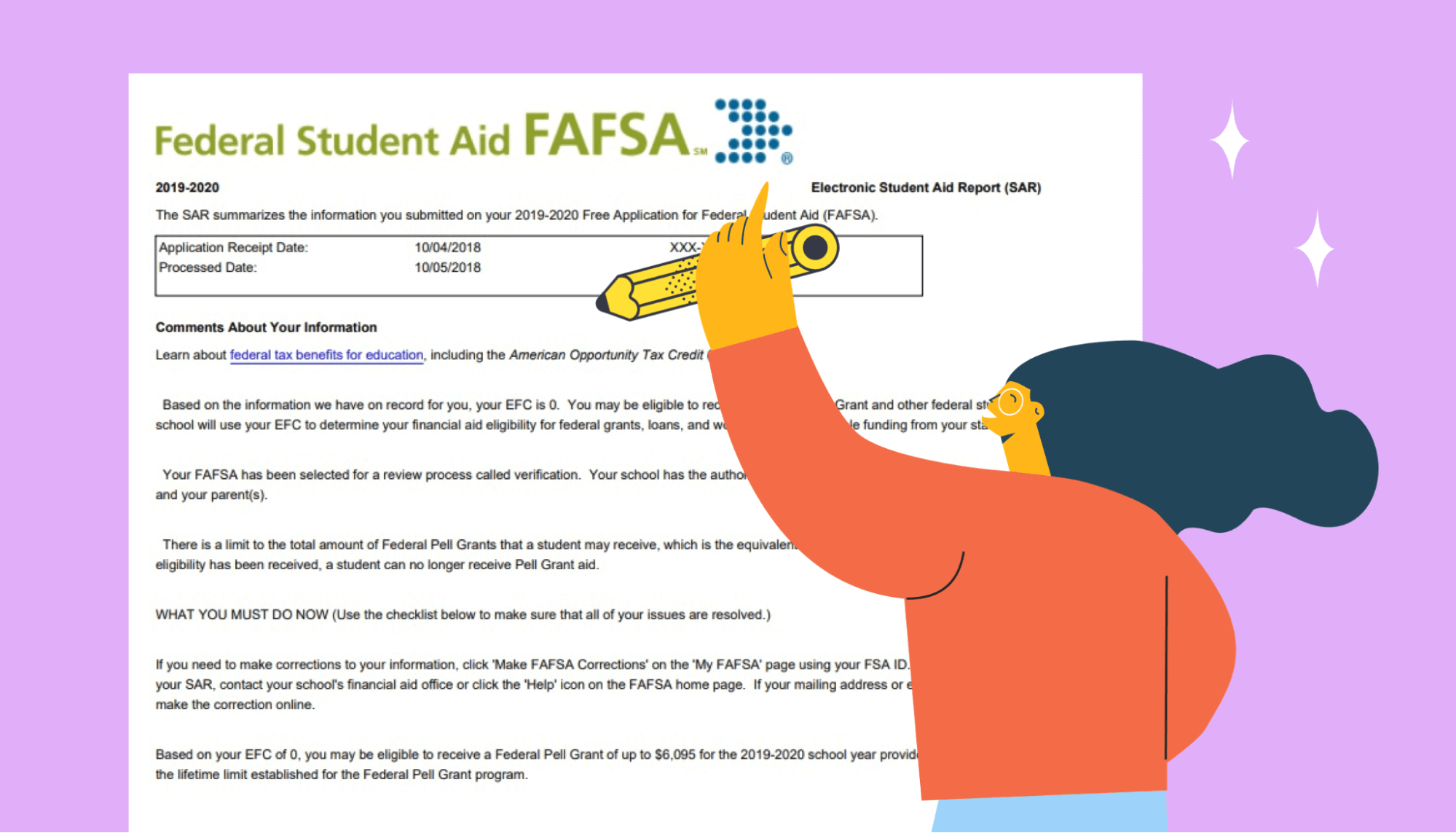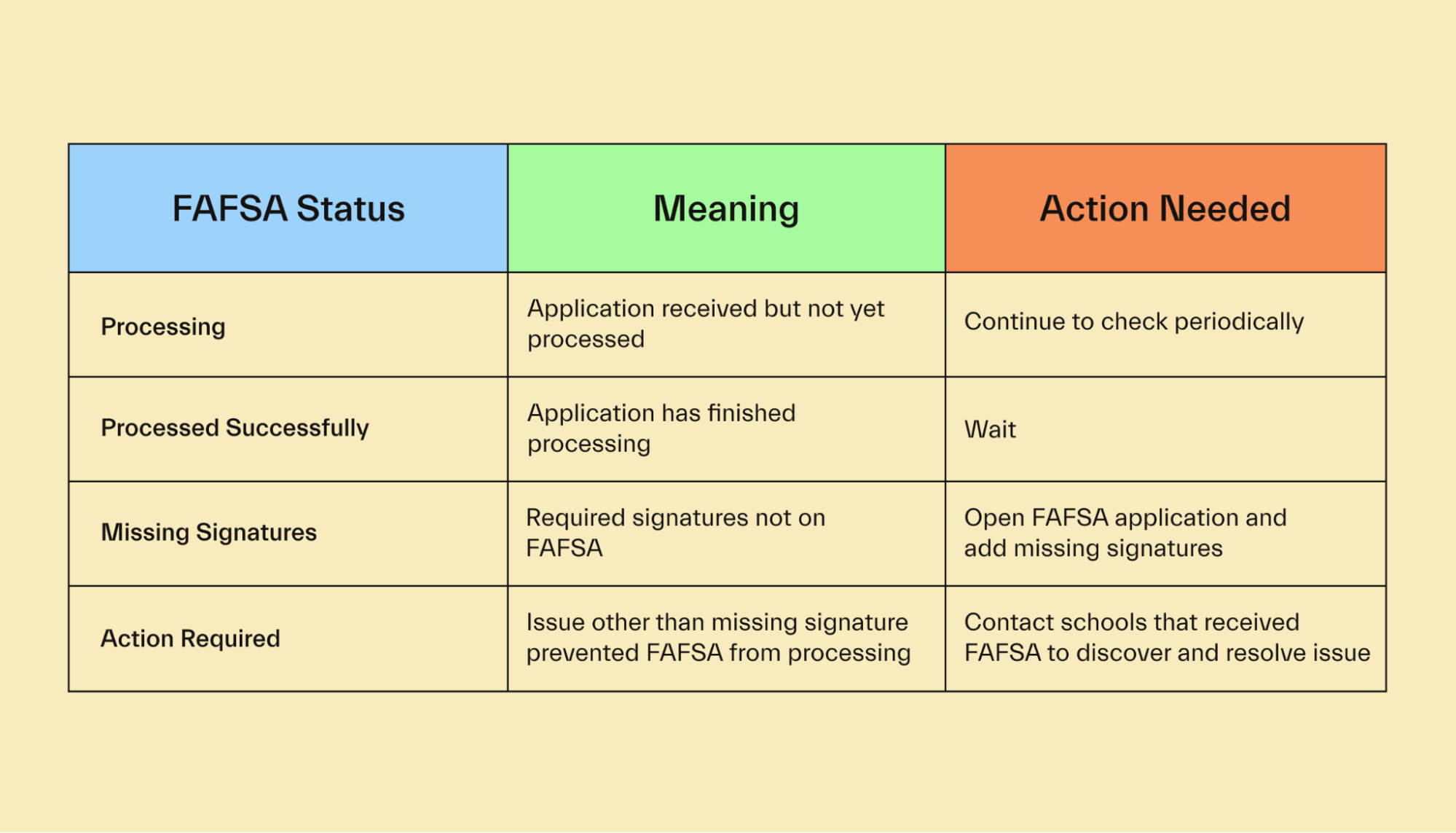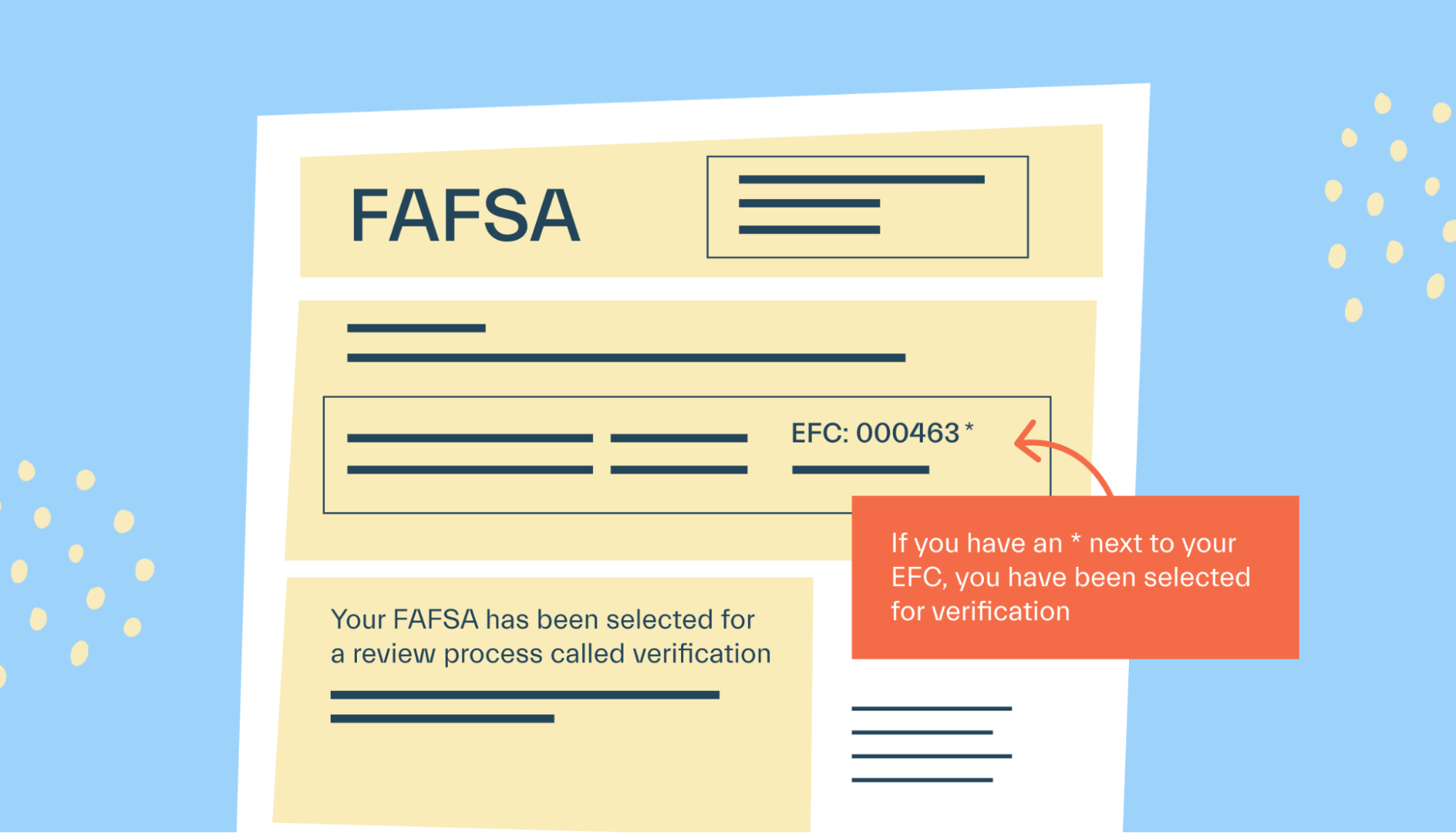FAFSA •
How to check your FAFSA status
The FAFSA takes days to process and occasionally runs into issues. Learn how to check your FAFSA status so you can fix problems and keep track of your aid.

You did it. You’ve sent your FAFSA, and you’re waiting for the government to tell you how much money you qualify for.
But days pass, and you hear nothing back. Your ability to pay for school hangs in the balance, and you’re becoming anxious.
Don’t worry. FAFSA takes a little while to process, and you can check your FAFSA status easily.
This article will explain what happens after you submit the FAFSA to help you understand why it takes a bit of time to process. Then, we’ll explain how to check your FAFSA status and what each status type means before closing with some FAQs.
What is the FAFSA?
The Free Application for Federal Student Aid, or FAFSA, is a form you fill out to qualify for most types of federal financial aid, including student loans, Pell Grants, and work-study.
Some state-based, school-based, and private aid programs also use part or all of your FAFSA to decide how much aid to give you.
You have to complete and submit the FAFSA every year to qualify for federal aid and other aid sources that use it. But don’t worry, because it costs nothing more than a bit of your time to complete. And you can often submit it much faster after your first time because it saves much of your info.
The FAFSA is due on June 30 of the year you want aid for. For example, the FAFSA for the 2022–2023 academic year is due on June 30, 2023. It’s hard to miss that deadline, but you generally want to fill the FAFSA out much earlier than that because your application can run into issues as you'll learn below.
What happens after I submit my FAFSA?
After you submit your FAFSA, the federal government processes it. Nearly 18 million students submit the FAFSA each year, so you won’t hear back right away.
You’ll just have to wait until it either goes through successfully or runs into issues. If you submit your FAFSA online, it’ll take 3–5 days to process. Submitting it by mail will increase the processing time to 7–10 days.
Once your FAFSA is processed successfully, you’ll get a Student Aid Report online or in the snail mail, depending on which delivery method you chose to submit your FAFSA.

On that SAR will be several key pieces of information:
Expected family contribution: Your EFC is a number the government uses to estimate your or your family’s ability to contribute to your education. Schools use this and their cost of attendance to determine your aid package. This will soon change to the Student Aid Index or SAI.
Data release number: A unique number you can provide to FAFSA customer service agents to make certain changes to your FAFSA.
Verification: An asterisk next to your EFC means you were selected for verification. You’ll need to provide more information to Federal Student Aid. More on this in our FAQ section.
Loan summary: Any outstanding federal student loans.
Where do I check my FAFSA status?
You can check your FAFSA status online at FAFSA.gov or by phone.
To check online, go to FAFSA.gov or open the myStudentAid mobile app and use your FSA ID and password to log in to your FAFSA.
You’ll be taken to the FAFSA portal. Click on “My FAFSA” to land on the My FAFSA page. You’ll find your FAFSA status there.
To check your financial aid status by phone, call the Federal Student Aid Information Center by dialing 1-800-4-FED-AID (1-800-433-3243).
What does my FAFSA status mean?
The Department of Education has several categories for your FAFSA processing status.

Processing
The “Processing” status means Federal Student Aid received your form but has not yet processed it. Since the FAFSA can take several days to process, don’t be surprised if your form remains “Processing” for a while.
There’s nothing you need to do here but wait and check periodically for your FAFSA status to change.
Processed Successfully
The “Processed Successfully” status means that your FAFSA went through successfully. You don’t need to do anything else unless you want to make FAFSA corrections later.
Once your FAFSA is processed successfully, you will get your SAR in a few days, as we mentioned earlier.
Missing Signatures
The “Missing Signatures” status means you or your parents have forgotten to provide signatures in 1 or more locations.
You’ll simply need to log in to your FAFSA online account to add the missing signatures. If you submitted a paper FAFSA, you can add the signatures to a printed copy of your SAR and mail it to the FAFSA processor.
Action Required
The “Action Required” status means there are other errors besides missing signatures that you need to fix. You’ll need to contact any schools that received your FAFSA to find out the issue and determine how to fix it.
FAFSA status FAQs
Have more questions about filing the FAFSA, checking your FAFSA status, or getting the aid you need?
Check out our FAFSA status FAQs below.
How long does it take to process my FAFSA?
FAFSA processing time varies according to your submission method:
Online: 3–5 days
Paper: 7–10 days
You’ll know your FAFSA is done if you check online and see a “Processed Successfully” status or receive your SAR in the mail.
You can also check whether your FAFSA’s been processed by calling the Federal Student Aid Information Center.
Is there any way to speed up FAFSA processing?
The government processes millions of FAFSA forms every year. Unfortunately, there’s no way to speed up your FAFSA processing.
But you can make the rest of the process faster by minimizing mistakes along the way. Here are some ways to knock out the FAFSA as quickly as possible:
Gather the documents you need ahead of time, and store them together in a safe place
Take your time filling out the FAFSA, and triple-check it before submitting it
Use the IRS tool to pull in tax information
Use last year’s FAFSA information, if possible
I’ve been selected for verification. What does that mean?
If you see an asterisk next to your EFC on your SAR, your FAFSA was selected for verification. This means the ED picked your FAFSA to check to ensure that the info you provided is correct.

Don’t worry—this doesn’t mean you’re in trouble. The ED randomly picks a sample of FAFSA each year just to ensure things are running smoothly.
However, you’ll want to cooperate earnestly and provide all the documents the ED asks for to the best of your ability. Waiting too long can delay your financial aid.
You might have to do verification for several schools, and some may give it another name, like “missing documents.” You’ll need to send the necessary documents to each of these schools separately.
If something turns out to be incorrect, you still may not get in any trouble. As long as you make a good-faith effort to fix errors on your FAFSA, the ED shouldn’t mind.
Can I make corrections to my FAFSA if it’s already been processed?
Yes, you can make corrections to your FAFSA application even if it’s already been processed, such as adding more schools or fixing incorrect information.
You can make these corrections online, by phone, or by mail. The process differs for each of these methods.
FAFSA corrections are generally due 3 months after the regular due date of June 30. That means September 10 or 11 of the year you’re attending school—in 2022, for instance, the deadline was September 11, 2022.
Don’t wait until the deadline, though. The faster you make the corrections, the faster you’ll know what your aid package looks like so that you can plan accordingly.
Plus, some FAFSA aid sources, such as work-study, are first-come, first-serve. Wait too long, and you could miss out on certain aid opportunities.
How long will my FAFSA aid take to direct deposit?
The time it takes to direct deposit depends on the financial institution. That said, it generally shouldn’t take more than 2 weeks. If you’re still waiting for aid you believe you’re owed, contact your school’s student accounts or financial aid office.
My FAFSA was processed successfully. How can I check on the status of my aid?
Once your FAFSA is processed and you accept your financial aid, you simply have to wait a little while before you officially receive your aid. You can check on the status of that money by reaching out to your school’s financial aid office.
When will I get my financial aid award letter?
Schools generally mail out financial aid award letters shortly after they send admissions letters. This means you can expect yours by mid-March to late April of the year you plan to attend school.

That said, schools can vary in how long they take to put together your aid package and send your letter.
Once you get these letters, don’t rush to accept them. Weigh your and your parents’ finances against which school you want to attend and how much aid they offer before moving forward.
How long does non-FAFSA aid take to process?
There’s no universal answer here—it depends on the type of aid and the organization handing it out.
For example, a massive scholarship competition like the Dr. Pepper Tuition Giveaway has a schedule that runs for several months over multiple stages and is handed out once per year.
Meanwhile, smaller or ongoing scholarships, like the Courage to Grow Scholarship, take only a few days to process since they run regularly and are quite simple.
I didn’t get as much aid as I needed. Can I appeal the FAFSA financial aid decision?
If you didn’t get as much aid as you needed, you can get your school to take another look at your situation by appealing your financial aid offer.
This may be a good idea if your financial situation has changed significantly since you filed—for example if a parent lost their job or your family encountered a substantial unexpected expense.
To appeal your FAFSA decision, you’ll need to:
Contact your school and let them know you’d like to appeal your financial aid decision
Gather documents relevant to the appeal decision. For example, if a parent loses a job, you may need some paperwork proving the loss of income.
Write a financial aid appeal letter. In this letter, you’ll make your case for the school to reconsider your aid decision.
Submit a letter and the relevant documents to your school’s financial aid office.
Keep yourself updated on your FAFSA
Several million fellow students apply for the FAFSA every year, so a response to your FAFSA won’t be immediate.
Fortunately, the ED updates your FAFSA status online. If yours is flagged, handle the issue ASAP to ensure you get the needed aid.
Otherwise, hang tight—there’s a good chance it’ll go through soon. In the meantime, check out our guide to the types of financial aid to better understand the aid available on your SAR and other types of aid you can look for.
Let's get
your money
- Get paired with a financial aid expert
- Get more money for school
- Get more time to do you





